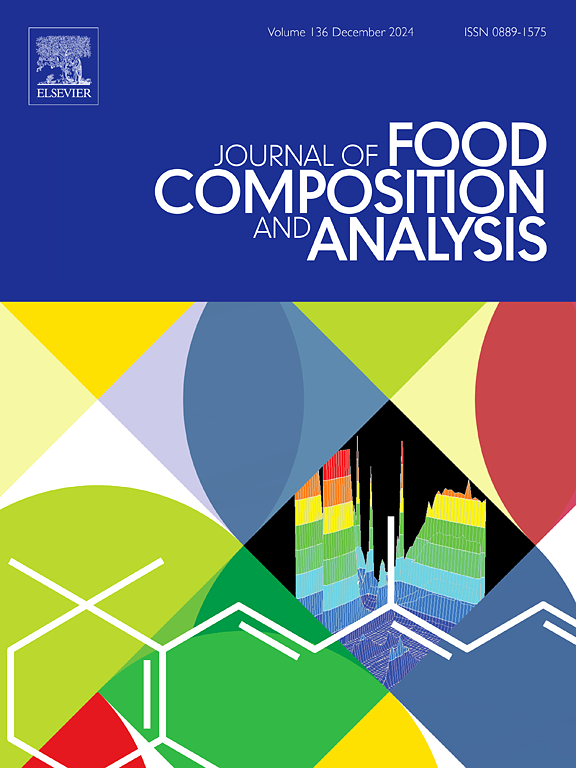Beyond current quality indices: Quantitative volatilomics unrevealed cultivar traits, harvesting practices impact, and aroma blueprint of extra-virgin olive oils
IF 4
2区 农林科学
Q2 CHEMISTRY, APPLIED
引用次数: 0
Abstract
Virgin olive oil, derived from Olea europaea L., is a staple in the Mediterranean diet and is classified into quality categories by EU regulations and the International Olive Council. Extra Virgin Olive Oil (EVOO), the highest quality, is valued for its nutritional and sensory attributes, driving consumer willingness to pay a premium. However, this makes EVOO susceptible to fraud, necessitating robust quality control methods. This study combines advanced untargeted fingerprinting and quantitative volatilomics using headspace solid-phase microextraction (HS-SPME) coupled to comprehensive two-dimensional gas chromatography with parallel mass spectrometry and flame ionization detection (GC×GC-MS/FID) on EVOOs from Hojiblanca and Picual cultivars to define robust markers of quality, named cultivar markers and cultivation practice indicators. The comprehensive analysis identified over 190 peak features and 84 compounds, revealing distinct volatile profiles influenced by cultivar, cultivation methods, and ripening stages. Of the 125 diagnostic volatile features (Fisher value > 4) for cultivar discrimination, alkenes, carbonyls, and alcohols predominate. Key compounds, such as (E)-2-octenal, (E)-2-hexenal, and (Z)-3-hexen-1-ol, reflect lipoxygenase pathway activity and maturation stages across cultivars. Quantification confirmed distinct aroma blueprints between cultivars, driven by differences in OAVs of key-odorants. However, minimal differences between odor active markers for organic and conventional cultivation practices, suggest consumers are unlikely to perceive variations in aroma between the two.
超越当前的质量指数:定量挥发物组学未揭示的特级初榨橄榄油栽培品种特征、收获方法影响和香气蓝图
初榨橄榄油源自欧洲油橄榄(Olea europaea L.),是地中海饮食中的主食,欧盟法规和国际橄榄理事会将其分为不同的质量等级。特级初榨橄榄油(EVOO)是质量最高的橄榄油,因其营养和感官特性而备受重视,促使消费者愿意支付更高的价格。然而,这也使得特级初榨橄榄油很容易受到欺诈,因此必须采取强有力的质量控制方法。本研究采用顶空固相微萃取(HS-SPME)结合综合二维气相色谱-平行质谱法和火焰离子化检测(GC×GC-MS/FID)对霍吉布兰卡和皮夸尔两种栽培品种的环氧乙烷进行了先进的非目标指纹图谱分析和定量挥发物组学分析,以确定可靠的质量标记、栽培品种标记和栽培实践指标。综合分析确定了 190 多个峰值特征和 84 种化合物,揭示了受栽培品种、栽培方法和成熟阶段影响的独特挥发性特征。在用于鉴别栽培品种的 125 个诊断性挥发性特征(费雪值为 4)中,烯类、羰基和醇类占主导地位。(E)-2-辛烯醛、(E)-2-己烯醛和(Z)-3-己烯-1-醇等关键化合物反映了不同栽培品种的脂氧合酶途径活性和成熟阶段。定量分析证实,不同栽培品种的香气蓝图各不相同,这主要是由于关键香味剂的 OAVs 存在差异。然而,有机栽培和常规栽培的气味活性标记之间的差异极小,这表明消费者不太可能感受到两者之间的香气差异。
本文章由计算机程序翻译,如有差异,请以英文原文为准。
求助全文
约1分钟内获得全文
求助全文
来源期刊

Journal of Food Composition and Analysis
工程技术-食品科技
CiteScore
6.20
自引率
11.60%
发文量
601
审稿时长
53 days
期刊介绍:
The Journal of Food Composition and Analysis publishes manuscripts on scientific aspects of data on the chemical composition of human foods, with particular emphasis on actual data on composition of foods; analytical methods; studies on the manipulation, storage, distribution and use of food composition data; and studies on the statistics, use and distribution of such data and data systems. The Journal''s basis is nutrient composition, with increasing emphasis on bioactive non-nutrient and anti-nutrient components. Papers must provide sufficient description of the food samples, analytical methods, quality control procedures and statistical treatments of the data to permit the end users of the food composition data to evaluate the appropriateness of such data in their projects.
The Journal does not publish papers on: microbiological compounds; sensory quality; aromatics/volatiles in food and wine; essential oils; organoleptic characteristics of food; physical properties; or clinical papers and pharmacology-related papers.
 求助内容:
求助内容: 应助结果提醒方式:
应助结果提醒方式:


